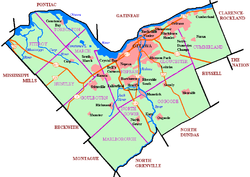Hunt Club
This article contains content that is written like an advertisement. (March 2017) |
Hunt Club | |
|---|---|
Neighbourhood | |
 Hunt Club-Riverside Park Community Centre | |
 Hunt Club | |
| Coordinates: 45°21′00″N 75°40′30″W / 45.350°N 75.675°WCoordinates: 45°21′00″N 75°40′30″W / 45.350°N 75.675°W | |
| Country | Canada |
| Province | Ontario |
| City | Ottawa |
| Government | |
| • MPs | David McGuinty |
| • MPPs | John Fraser |
| • Councillors | Riley Brockington |
| • Governing body | Hunt Club Community Association |
| • President | Brian Wade[1] |
| Area | |
| • Total | 5.072 km2 (1.958 sq mi) |
| Elevation | 95 m (312 ft) |
| Population (2016) | |
| • Total | 12,264 |
| • Density | 2,418/km2 (6,260/sq mi) |
| Canada 2016 Census | |
| Time zone | UTC-5 (Eastern (EST)) |
| Forward sortation area | K1V |
| Website | Community Association |
Hunt Club is a community in River Ward, in the south end of Ottawa, Ontario, Canada. The area is named after the Ottawa Hunt and Golf Club, which has been part of the area since 1876. Hunt Club Road and many local businesses were also named after the golf course.[2]
Hunt Club is located just north of the Ottawa Macdonald–Cartier International Airport and to the east of the Rideau River. The Hunt Club Community Organization defines the boundaries as the Rideau River to the west, the Airport Parkway to the east, the CN Albion line and Via Rail Beachburg Subdivision to the north and Hunt Club Road to the south.[1][3] The population of the area is 12,264 as of the 2016 Canadian census.[4]
16% of the area is publicly-accessible green space. It has three times the green space as the Ottawa average, including the Sawmill Creek wetlands and Rideau River shoreline. Hunt Club has seven city parks: Cahill, McCarthy, Owl, Paul Landry, Riverwood, Uplands, and Uplands Riverside.
Hunt Club has a widely mixed demographic in age groups, ethnocultural backgrounds, socio-economic levels and family set ups. The area also has the second largest Asian Canadian population in Ottawa. Housing in the area includes single dwellings, semi-detached and townhouse units, apartment buildings, retirement homes, and housing projects.
Hunt Club was originally settled by Europeans in the early nineteenth century. It was originally part of Gloucester Township. In 1950 the still largely rural area was annexed into the city of Ottawa. Development of the area began in the 1970s, and many houses and buildings in the area are from this period. It was designed as a bedroom community with little commercial area.
One of the more prominent and controversial areas of the neighbourhood is the large Hunt Club Woods area. This region next to the CN rail lines was purchased by the National Capital Commission in 1953 with plans of turning it into part of a major ring road around Ottawa. These plans never materialized and the area has been an undeveloped mix of farmland, meadows, and forests ever since. The NCC hopes to sell their considerable holdings to developers and have the area turned into a new subdivision. Residents and greenspace advocates have fought this, hoping to preserve much of the area as open land.[5]
Sub neighbourhoods[]
(from west to east)
- Quinterra
- Hunt Club Woods
- Hunt Club Estate
- Western Community
See also[]
- List of Ottawa neighbourhoods
References[]
- ^ a b "Our Association". Hunt Club Community Association.
- ^ Club, Hunt. "The Best Recruiters | Hunt Club". www.huntclub.com. Retrieved 2021-10-19.
- ^ https://hunt-club.ca/map.html
- ^ Population calculated by combining Census Tracts 5050002.04, 5050002.06, 5050002.05 and 5050002.02, while removing dissemination blocks 35061248020, 35060875002 and 35061487015
- ^ Club, Hunt. "The Best Recruiters | Hunt Club". www.huntclub.com. Retrieved 2021-10-19.
- Neighbourhoods in Ottawa
